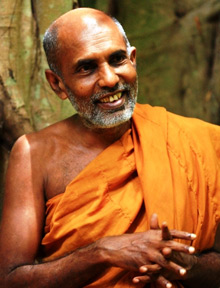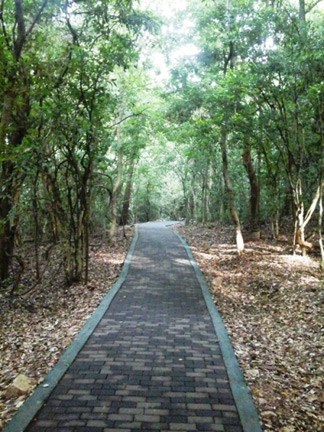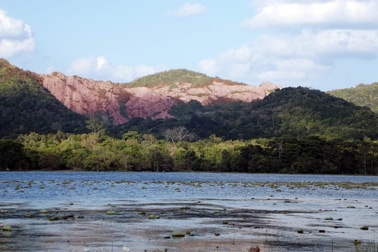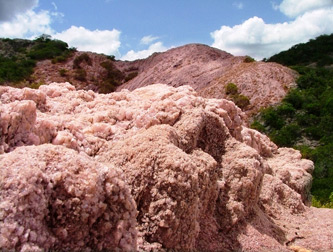Jathika Namal Uyana - nature's gift
By Namal Rajapaksa, MP
Our country often referred to as the pearl of the Indian Ocean is
about 65,610 square kilometres in extent and it is blessed with varying
favourable climatic conditions. It is indeed through sheer luck that we
have been fortunate enough to make this island our beloved motherland.
|

Ven.Wanavasi Rahula Nayaka Thero |
|

Namal flowers in bloom |
The world famous Rangiri Dambulla located at the centre of this
resplendent island is a place of significant historical importance. A
vast expanse of natural virgin forest with a high bio-diversity lies
just 15 kilometres away from the Dambulla Town. It is about two thousand
five hundred acres in extent and is a national treasure.
The forest lies just a few kilometres away from the Madatugama
junction along the main A9 route running from Dambulla to Jaffna. One
has only to travel through the Jathika Namal Uyana road towards
Aandiyagala and on reaching Pubbogama travel just two milometres to
reach the Jathika Namal Uyana.
This historic site is located between two picturesque hamlets called
Ulpathgama and Ranawa in the Police Division of Galkiriyagama in the
Palagala Divisional Secretariat Division in the Anuradhapura District.
Having been only recently discovered, it was quite unknown until about
two decades ago. However, nobody other than shady characters such as
illicit timber merchants, treasure hunters, cruel game hunters would
have caught even a glimpse of this natural treasure.
Along this trail you could gain access to National Namal Uyana, the
natural park of Sri Lanka that literally saw the light of day through
the 'Revolution on the Mora Tree and glorified by the biggest rose
quartz deposit in South East Asia. The Namal Park is located in a
climatic zone displaying the features of both the dry zone weather
during certain period of time and wet zone weather in the other months
of the year. Anybody visiting this site during any month of the year
would feel comfortable and would be attracted to its immense beauty. It
is unbelievable wonderful creation of Mother Nature exists in this land.
The Jathika Namal Uyana, is the largest ironwood forest in Sri Lanka.
Asia's largest rose quartz mountain situated within the 'Jathika Namal
Uyana.'
The Ironwood Tree Mesua Ferara is an extremely rare tree that is
endemic to Sri Lanka. It is the national tree of the country. The
replanted forest is over 260 acres in extent. Namal Uyana had been a
sanctuary for Bhikkhus during the period of King Devanampiyatissa in the
3rd century BC. Later, during the time of King Dappula IV (941-945 AD)
it had been used as a human sanctuary and/or prison camp where the
punishment was to plant ironwood trees. Archaeological findings show
that during certain periods of history, Namal Uyana had also been used
as a meditation centre by Bhikkhus.
|

The paved passageway, lined with Namal trees |
Ruins of an ancient Dagoba, huge
stone pillars, a Buddha statue and a moonstone confirm its past
uniqueness as a place of religious worship and meditation. This unique
natural treasure was brought to the attention of the world about 22
years ago, by an environmentalist Buddhist monk named Venerable Wanawasi
Rahula Thera.
The biodiversity of the ironwood forest is unique in that it also has
more than 100 species of tropical plants of which 82 are herbal plants.
About 20 bird species and a number of mammals including elephants,
leopards, monkeys and deer also dwell in the park and the jungles
bordering it. The Rose Quartz mountain range at Jathika Namal Uyana is
the largest of its kind in Asia.
The row of seven rose quartz mountains is situated at an elevation
varying between 180 and 300 metres above sea level. According to
archaeological researchers this pink quartz mountain has a history of
more than 500 million years. According to legend Emperor Shah Jehan had
used pink quartz from this mountain for his masterpiece, the Taj Mahal
in India. If that is the case, then there should not be any doubt about
the quality of the Rose quartz found in this massive deposit. It is an
invaluable national treasure.
It is quite strange to note that it is difficult to find a trace of
gneiss rock within the area of the rose quartz deposit, 600 acres in
extent. The entire site of the Jathika Namal Uyana is 2,500 acres in
extent and it contains historical evidence in the form of ruins of
ancient Buddhist structures and monuments.
It is intended to discuss some of the historical facts revealed so
far in relation to the Jathika Namal Uyana. Ranawa is the village in the
eastern border of this national park. The historical site where the
Vijithapura Battle between King Dutugamunu and the Tamil King Elara took
place just about 15 kilometres away. United this country under one
administration only after victory gained in this battle. It is said that
people from Ranawa had produced weapons needed for the army and that in
fact the people from Ranawa had even participated in the battle as
soldiers of King Dutugemunu. The famous Aandiyagala Pillar inscription
believed to have been erected by King Dappula V is located just in front
of the historical Devurada Randada Vihara.
The Aandiyagala Pillar inscription states that even a person guilty
of treason is free to stay within the enclosed premises and even the
king is powerless to arrest such a person within the boundaries of the
site. Furthermore it has been identified that the forest comprising
Namal Uyana surrounded by the villages of Morothegama, Ulpothagama,
Naramgasvewea, Ranawa and Dambuluhalmillewa had been the first and the
only sanctuary in the world open for wild life as well as the human
beings. This historical fact is sufficient evidence to prove the
historical importance of Namal Uyana.
|

The National Namal Uyana is by far the largest 'Na’ forest
in the island |
Not being satisfied with the information gathered from various
sources about the marvels associated with this historic site, I ventured
recently to explore the serene beauty of the site. Right throughout from
the main access gate of the site, Namal Uyana displays the beauty of the
magnificent Na Tree found abundantly on every side of the park.
The history of Buddhism tells us that the previous Buddhas, Mangala,
Sumana, Ruvatha and Sobhita had attained Buddhahood at the base of Na
trees. As such the Na tree is considered sacred, throughout Buddhist
history and anyone entering Namal Uyana would realise how this concept
justified is, event today. The captivating fragrance wafts from the Na
forest soothes even a person with a heart of stone.
The National Namal Uyana is by far the largest 'Na' forest in the
island, extending for over 250 acres. The buds of Na leaves that enhance
the beauty of the Na forest could easily be compared to lips of young
women. In view of these unique features the Government has declared the
Jathika Namal Uyana, a National Heritage site on April 26, 2005, under
the Department of Wild Life Conservation.
When you travel a few more metres under the canopy of the Na forest
you come across a large Mora Tree that is especially significant in the
context of the Jathika Namal Uyana. It was this 'Mora Tree' that had
given shelter to the founder of the National Namal Uyana, Ven. Wanawasi
Rahula Thera, who was not only the person responsible for introducing
this national heritage to the environmentalists of Sri Lanka but also
the person who continues to look after this treasure as his own life.
This historic tree had secured the life of Ven. Rahula Thera from the
possible attacks from wild elephants, other cruel animals and poisonous
snakes that were found in large numbers all over the place.
|

The rose quartz mountain found in the centre of Namal Uyana |
This is clear evidence to the fact that mother nature always renders
assistance to the existence of the human beings even though human
activities bring about destruction to mother nature. One can gauge how
much Buddhism loved the environment when one ponders over the following
extract from Buddhist literature, I.e. Rukkho chaya makanam Karothi -
meaning 'the tree renders shade to everybody irrespective of being a
friend or foe.' It is frightening to imagine that a person takes shelter
in a hut put up on the branches of a tree in thick jungle where
evidently no other person is living, within the limits of that thick
jungle. A Buddhist priest resorting to such hardship for the welfare of
mankind is all the more amazing as well as significant.
In this regard Ven. Wanavasi Rahula Thera pointed out to me that one
who protects the environment is in turn protected by the environment in
the same way as one who practices the Dhamma is protected by the Dhamma
- "Dhammo have rakkhati Dhammachari". Indeed Ven. Rahula Thera keeps
immense faith with the environment and is friendly and loyal with it.
The historical monuments found and excavate in the site of the
Jathika Namal Uyana bear testimony to the long and colourful history of
the site, extending from the era of one of the earliest Kings of Sri
Lanka, King Devanampiyatissa upto the time of King Dappula V in the 10th
century AD. This has continued to be a Buddhist religious site as proved
by the ruins found here.The sacrifices made by Ven. Wanavasi Rahula
Thera for the protection and preservation of this sacred and picturesque
heritage site are immense indeed. Anybody visiting the place today would
realise such sacrifices made and the extent of hard work done for the
preservation of this site.
It is on the one hand, an environmental university where students as
well as researchers could study the biodiversity of the site and
especially the marvels connected with the rose quartz mountain range.
There is ample opportunity here for the development of the tourist
trade as well. Even today thousands and thousands of tourists both local
and foreign flock to have a glimpse of this wonderful creation of Mother
Nature. We must all be thankful to Ven. Rahula Thera for laying the
foundation and also maintaining such a money spinner for the country's
economy.
When one considers all these facts it is very obvious that Ven.
Wanavasi Rahula Thera is a unique personality and a true son of Mother
Lanka. He always does the correct thing rather than opting to please
others through various means. It was through a dream he saw one day that
Ven. Rahula Thera got the idea of venturing into this Na forest and
developing it as one of the greatest heritage sites of Sri Lanka.
In this regard Ven. Rahula Thera is grateful for the services
rendered by all including the media for the support rendered all
along.We must all give our best for the protection and preservation of
this unique creation of Mother Lanka.
Namal Rajapaksa, MP Hambantota District, Chairman, National Namal
Uyana Development Trust. |

